A lot of work over and under the waterline
After many years in the sun and in the salty water, a hull needs to be refurbished in order to regain the shiny surface it once had. Further to the work above the waterline, it is equally important to look after your underwater body.
Another issue that becomes visible after a dozen or so years is the fact that the stern starts to fade differently and thus varies in colour compared to the rest of the hull. The border between the sides and the stern can become quite significant showing different shades of white. This is due to the fact that the stern is produced separately during the production of the new hull.
Last, but not least, the blue stripes along the waterline need to be repainted (the thick blue stripe further up is inserted into the gelcoat and is thus polished).
We started the hull project by polishing the sides; 30 hours on each side – 60 hours in total. And that’s excluding the stern! It is a lot of work but definitely worth it on a Hallberg-Rassy, which has a very thick layer of gelcoat. On some cheaper brands you might need to be more careful since you don’t want to polish through the gelcoat. On a Hallberg-Rassy, this is no issue.
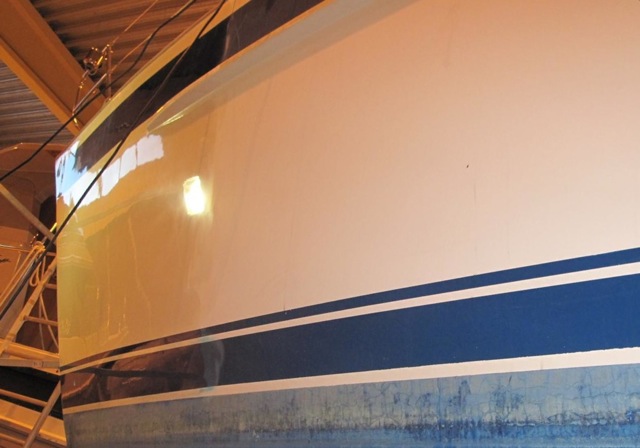
The forward part of the boat (left) has received its first go of polish, while the section further aft is still lacking the shiny surface (from center to the right)
I must say it is impressive how much a high quality hull can regain its shiny surface.
As a next step the entire underwater body was investigated regarding moisture. The boat has been laying in the water for a long time, except for the last 2,5 years. Hallberg-Rassy gives each new boat two coats of epoxy before adding antifouling. On the other hand, the paint manufacturers recommend 6 layers of the same to obtain enough water tightness. I want to follow the paint manufacturers’ recommodations and thus wished to take off the coats of antifouling in order to add 4 extra layers of epoxy (giving 6 in total). For this reason the entire hull was examined by a professional surveyor.
Luckily, the hull was totally dry. Even the rudder (the rudder often tends to be quite moist acctually) and around the exhaust was dry with one exception: in an area around the through hull close to the waterline on the port side, we could measure 2,5% moisture. This is typical for a HR46, since I know others have had the same problem at exactly the same place.
Otherwise, Regina Laska was very dry. This might be thanks to the original two epoxy coats by Hallberg-Rassy, but I believe it’s more because she has been standing out in the dry in Italy and Sweden for the last 2,5 years. In order to keep her dry, we decided to add more epoxy before the launch.
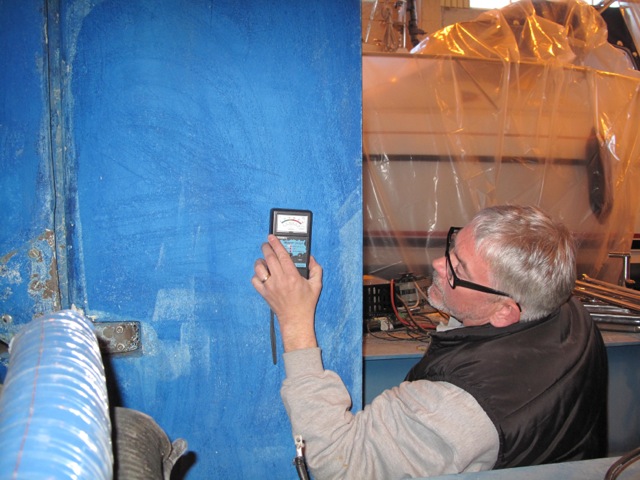
The entire underwater body was measured thoroughly. Even the rudder (picture) was extremely dry, which is not the case on every boat.

Also around the exhaust, she was dry.

The through-hull at the waterline which was leaking, which is the case on some other HR46’s I know of.
We disambled the old through-hull along the waterline where the manual bilge pump hose ends in order to find out why it is leaking. The reason became very obvious: Hallberg-rassy had drilled through both the outer laminate and the inner laminate and only filled the area in between with chemical metal, replacing some of the Divynicell. With the force given when tightening the through-hull, it can’t widthstand the pressure and a small hole into the Divynicell forms.

Cutting out a square around the hole to investigate what is wrong and installing a new hole the proper way, tightening it only through the outer laminate.

This is how a through hull along the waterline should be installed in order to remain tight. Higher up it is fine to go through both inner and outer laminate but under and along the waterline it should be through the single laminate.
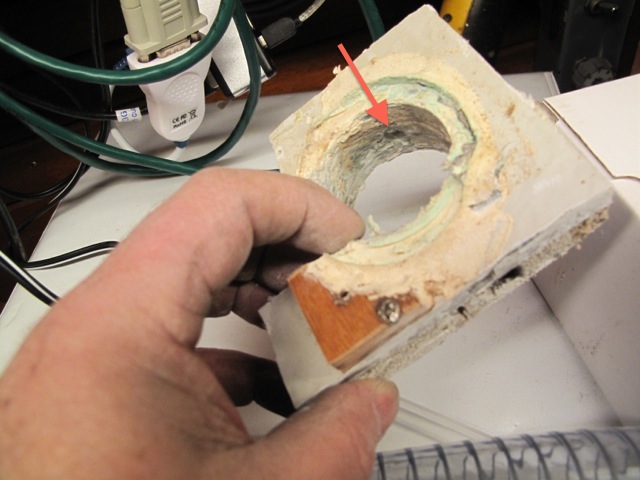
The cut out piece showing the hole where the water has been able to leak into the Divinycell

The through hull is green on the side where the leakage was
It became time to release the antifouling from the boat. Sanding by hand, sand-blasting or ice-blasting are the alternatives. I was interested in testing the latter and so Isblaster became part of the refit team. Hannu Utrianinen came with his gun and ice and worked two full days in order to remove the old antifouling. The advantage with ice-blasting is first of all environmentally, since there is no sand to take care of later. The CO2 with its temperature of -70 C evaporates and the old antifouling lands on the plastic sheet underneath. Second of all, while sand blasting is very tough to the underlying surface, ice is much softer and only removes the antifouling but leaves the epoxy and especially the gelcoat untouched. Or at least this was what we thought. We got two surprises.

Regina Laska has been covered in plastic to collect the antifouling and is ready for the ice-blasting

The start of a long two days of work: Hannu Utriainen is starting to shoot off the blue antifouling. Underneath the gray epoxy, but also some patches of white gelcoat under the expoxy
After some hours of hard work, we discovered our first surprise: The gelcoat of the Hallberg-Rassy had not been sanded before adding the epoxy when she was originally built. Therefore, the gelcoat was still so even that large patches of epoxy was loosened by the ice. Hannu said this is not normally the case since the epoxy should stick hard onto the gelcoat, which is achieved by sanding the gelcoat before adding the epoxy. Apparently, Hallberg-Rassy still does not sand before painting the (two layers) epoxy.

The gelcoat (white) under the epoxy (gray) is still shiny, which it should not have been in order to give a good underlying surface for the epoxy.

After two days of work: Regina Laska looks all blue when she is uncovered. Not a very attractive sight!

Regina Laska is transported back into her shed for further treatment
Back in the shed, surprise number two was discovered. When you build a hull, all air bubbles should carefully be rolled out by hand. However, large patches of Regina Laska’s hull had not been rolled out properly so air had been trapped behind a very thin layer of gelcoat. You could actually see the areas where the men had been missing to roll well enough. These bubles of air trapped behind the gelcoat should not be mistaken by osmosis which smells and is water that has penetrated the hull.
Despite the ice being very gentle with the hull, it shot through the the thin gelcoat and left thousands of tiny holes in the hull. The sight was not uncommon by the experienced members of the team, since other brands have the same problem with some hulls. It is very good that it is discovered, since how it can be treated correctly by filling all the hulls, which is a tremendous work.
During one day, we drilled up all holes so they became small craters instead of the tiny holes. This is the only way in order to fill them with polyurethane body filler, which was done the following day. As a last step, the entire hull had to be hand-sanded in order to give a smooth surface where epoxy and gelcoat meet.

Opening up thousands of tiny holes in order to fill them

You thought the job would never end!
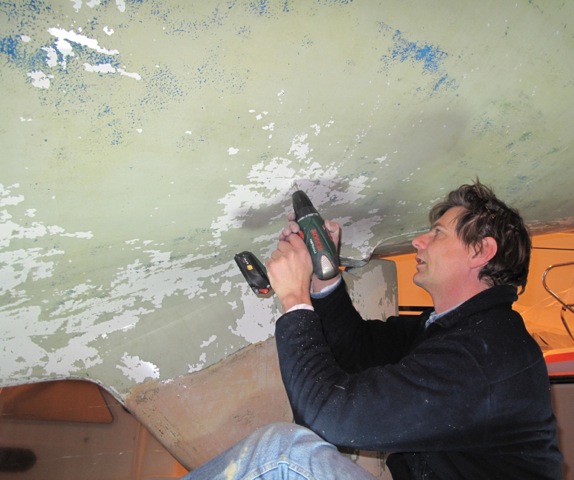
During night I was dreaming about holes!

Wile working on the hull, it was just as well to fill also these issues

Time to fill all the holes with polyurethane body filler. I shouldn’t really smile this much… The holes are so small and so close, and I am almost 50 – so I began using reading glasses. Reading holes!
After drilling and filling it was time for sanding. It took another full day.
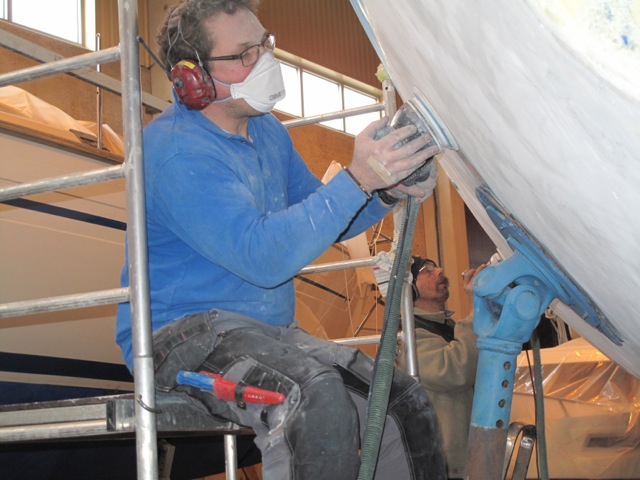
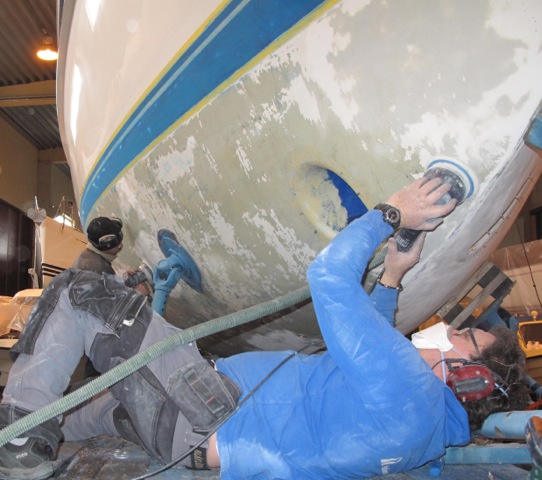


Half the port side done! To the left it has been sanded, while the aft to the right still needs a go!
Early mornings and late nights moved us forward from sanding to giving the 6 new layers of epoxy. Every other layer in gray and every other layer in green. That way, one could exactly see where it has been painted.

Mixing the first (green) layer of the two component epoxy.

Two men making a witches brew: Hwooo! This stuff makes your head turn round!

The first strikes of 6 layers of epoxy. A long way to go with 5 hours drying time in between. We were working around the clock to keep the time schedule.

After 6 layers the final (grey) coat of epoxy! Hurray!

The first coat of two of antifouling; we’re not quite ready, yet.

The underwater hull is ready. Time for a good night sleep!
The stern became our next challenge. Siviks Marin became part of the refit-team and Martin Ahl is an expert in working with GRP plastic. Martin has been a foreman for Hallberg-Rassy molding all the hulls in Kungshamn so he really knows how hulls are being built and I am glad to have him onboard.

The stern with the old gangway attached that is no longer requested for the intended type of sailing

The boat must have backed into a quay with the gangway taking the force. This crack needs to be totally repaired

The old stern how it looked when the fittings were taken off.

Carl Adams is filling the holes that are no longer needed (e.g. for the hydraulic gangway)

Working with holes

This is when Siviks Marin took over: all hole are filled and the stern is ready to be sprayed

After the first coat of paint. A lot of polishing follows

Martin Ahl working on the transom giving it a last touch

The final stern looking fantastic!
While the boys were working on the stern and the underwater hull, Anna Friberg from Orust Lack was working on the blue stripe along the waterline. First it had to be masked with tape and sanded down. Interestingly enough, we found that the original masking was not perfect so Anna, who never can leave anything less than perfect, redid the masking at the bow and at the stern in order to become 100% symmetrical. As a last step she painted two coats of blue onto the stripe polishing it to a perfectly shiny surface.

Anna masking the stripe to get the new stripe 100% perfect

It takes many hours to sand down the stripe by hand before adding two coats of new blue

Anna concentrating on the sanding of the thin stripe on the top

The final stripe before taking off the masking tape and the readily painted antifouling and polished hull. She just looks like new!

Regina Laska taking some fresh air. Her hull is ready and better than ever, protected for many more years in the sea.

